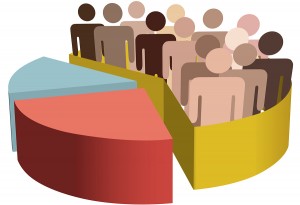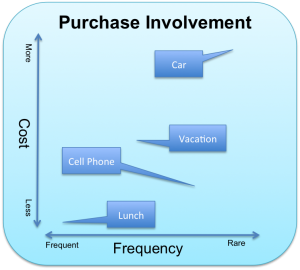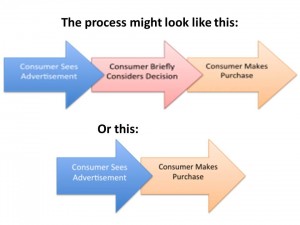As a new contributor this blog, let me begin by introducing myself. My name is Dave Bilbrough, and I am a Solutions Architect on the SAS Customer Intelligence team, specializing in Digital Marketing. I am pleased to bring a digital perspective to the this blog seen through the prism of my background in web analytics, search marketing and online advertising. I hope you find my views helpful! To start off, I'd like to explore the notion of "right time / right place" and what it means in marketing with this thought:
Ever wonder what is going through your customer’s minds
prior to their deciding to purchase your product?
 If that is the case, well then you are in luck today! In this post, we will be examining consumer behavior leading up to and including the purchase decision, with an emphasis on how you can position your marketing to intersect with the consumer at just the right moment. Because hey, timing is everything, right?
If that is the case, well then you are in luck today! In this post, we will be examining consumer behavior leading up to and including the purchase decision, with an emphasis on how you can position your marketing to intersect with the consumer at just the right moment. Because hey, timing is everything, right?
There are a lot of ways that different consumer segments approach purchase decisions in various industries, but there a few aspects that are common to many of them. One of the great distinguishing factors for predicting a consumer’s purchase decision process is purchase involvement. It’s a pretty simple concept – a more involved purchase will generally have a more extensive decision process. In order to assess the involvement of your particular good or service put yourself in the shoes of an average consumer and walk yourself through a couple of questions
- How many times in my life will I make a similar purchase?
- How expensive is this item?
Now, let’s consider a couple of purchase decisions that many people would be familiar with and answer these questions. For example, lunch – assuming the consumer in question is a living, breathing human being that requires sustenance, they will likely purchase something to eat nearly every day. And depending on that person’s tastes, lunch is fairly inexpensive. On the other end of that spectrum is an automobile. Although there are exceptions to every rule, most people will likely purchase fewer automobiles in their lifetime than they will meals. And it probably isn’t going too far out on a limb to speculate that your car costs more than your lunch.
We can then revisit economics 101 (or visit for the first time, if that is the case) and make a diagram as follows that depicts some common items along our purchase involvement graph: 
The top right corner of this graph represents highly involved purchases, for which consumers are more likely to consider multiple alternatives, do extensive research, and in general they will agonize over which choice to make.
For example, several steps commonly involved in purchasing an automobile would be to read government safety ratings, compare fuel efficiency, research future maintenance costs, and then test drive multiple vehicles. These steps would be far less common in a less involved purchase, such as a bag of potato chips or a pencil.
Why do you need to understand the consumer purchase process for your product or service?
Once you understand how consumers typically go about purchasing your product/service, you can then be more productive in developing an effective strategy for how to reach them with your message. For example, in many high involvement purchase decision processes, it is best to catch consumers in the evaluation stage. They have already identified their need for the product/service, and your best opportunity is to sell them on your company while they are evaluating alternatives. Alternatively, for many low involvement purchases, you may be best off hitting an unsuspecting consumer with an ad in order to create demand. More on this below. In the meantime, let’s examine a couple of examples of purchase processes.
 For more involved purchases, the steps usually resemble these:
For more involved purchases, the steps usually resemble these:
.
Notice how I didn’t title the last step “Consumer Makes Purchase”, because in many cases, the consumer may have come up with an option that doesn’t involve making a purchase. Maybe your pitch wasn’t convincing enough? Maybe. But more likely, you didn’t even get to make your pitch.
According to a recent study by ComScore, approximately 70% of consumers research purchases online prior to making a purchase. Many of them use Search Engines to find information relating to the product/service they are researching. Want to know if keywords that relate to your product/service was among the searched for terms in your area? I thought so. I’ll explain how to do that in next week’s blog entry. In the meantime however, it’s a pretty safe assumption that if your product/service is legally and logistically available for purchase or consumption in your chosen area of business then consumers are probably using search engines to look for it.
This means that even if the typical sales process for your product or service is very hands on and involves a sales team, chances are likely that your customer has already done considerable research before they ever engaged you in the process. In this scenario, your sales pitch is coming between steps three and four, and thus the consumer has already identified and evaluated their options prior to ever talking to you. Not exactly the point in the process you were hoping to engage them, right? I didn’t think so. Enter search engine marketing (herein referred to as “SEM”) and thus, the ability to change your location in the process.
 Wouldn’t you like your odds better if the process looked like this?
Wouldn’t you like your odds better if the process looked like this?
The core concept behind SEM is that if a user is performing a search for a term related to your product/service, that represents an opportune time and place for you to serve them an advertisement.
Let that one sink in for a minute, and consider some examples. If you sell cars, wouldn’t you love to have the opportunity to get a few words across to everyone who types “reviews for new cars” into a Google search bar? If you build houses in Charlotte, NC, wouldn’t you love to chat with someone who types “homebuilder in Charlotte, NC” into their browser? If you said yes, then consider yourself a great candidate for SEM. You have a few options:
- You may refer to the Google guide to SEM agencies to find an agency for your business
- Read up on SEM yourself, and run your own campaigns. I am a big fan of Advanced Google Adwords by Brad Geddes.
Now, for less involved purchases, the decision process differs from that of a product with a high purchase involvement in that the evaluation stage is often much shorter, and that the consumer is not always aware of their own need for a particular product.
 A great example of a consumer not being aware of their own need for a product includes a billboard for a restaurant along the side of a highway. The consumer may have not identified their need at that point, but after a tempting photo of a delicious looking meal, they may suddenly be hungry.
A great example of a consumer not being aware of their own need for a product includes a billboard for a restaurant along the side of a highway. The consumer may have not identified their need at that point, but after a tempting photo of a delicious looking meal, they may suddenly be hungry.
And the evaluation process for a purchase that a consumer will make many times in their life is shorter since the repercussions of making a poor decision are generally much lower. For example, if you don’t like your potato chips – just get another bag of different ones. If your pen runs out of ink, just get another. A consumer might make a choice for a low-involvement purchase based solely on convenience, timing, proximity, or just to try something new. They might also do far less research.
However, that doesn’t mean that SEM is necessarily ineffective to promote a low-involvement product or service. It just means a different strategy is necessary. Rather than focusing on keywords for searches that would indicate a consumer is looking specifically for your product/service, you could instead focus on creating the need for your product/service in the mind of your consumer. For example, if you are marketing a restaurant that is located near a hotel, airport, stadium or other landmark, you could focus on searches that include the title of the landmark and plant the idea of eating in your restaurant in the mind of someone preoccupied with another task in the same manner that marketers placing billboards on the side of the highway do.
I first shared this post on my personal blog, and I'm happy to share it with you here. Check back for other thoughts I'll share on digitial marketing, or subscribe to this blog (see the box to the right and above) and get posts delivered to you via email. Either way, I appreciate your following! Please let me know what you think with a comment below.

2 Comments
Very good post and I would like to give especial emphasis to the importance of purchasing involvment as key to understand how customers purchase.
Cool blog.
Great tips. I have read an interesting article about user persona. It means targeting your consumers - what they want and need. Imagine, if the content is targeted to the consumer, it's like talking to them and convincing them to buy your product. That would help in your website's ROI.